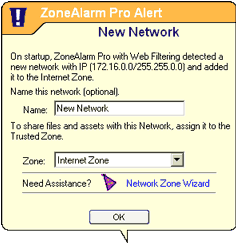 Responding
to alerts
Responding
to alerts Responding
to alerts
Responding
to alertsWhen you start using ZoneAlarm Pro, you are likely to see three types of alerts: New Network alerts, New Program alerts, and Firewall alerts. Read below to learn what these alerts mean and how to respond to them. For information about all types of alerts, see the related topic ZoneAlarm Pro alerts.
 The
first time you use ZoneAlarm Pro, you will almost certainly see a New Network
alert. Don't worry! This alert is a convenience tool designed to help you configure
ZoneAlarm Pro.
The
first time you use ZoneAlarm Pro, you will almost certainly see a New Network
alert. Don't worry! This alert is a convenience tool designed to help you configure
ZoneAlarm Pro.
There are two possible causes for the alert:
• ZoneAlarm Pro has detected your home or local area network.
• ZoneAlarm Pro has detected your ISP's network.
The distinction is important, because you may want to trust the computers on your home or local area network—but you probably don't want to trust all the computers connected to your ISP!
Click the link below that best describes your situation:

As you begin to work with ZoneAlarm Pro, you will probably see one or more New Program Alerts.
Again, don't worry! New Program alerts help you to give access permission to programs that need it—like your browser and e-mail program. They also let you deny permission to programs that you don't want to access the Internet.
New Program alerts occur when ask for Internet or local network access for the first time.
To decide how to respond, consider these questions:
• Do you recognize the Program Name? (For example, "Microsoft Outlook")
• Does it makes sense that this program would need Internet access? (For example, am I actively using this program?)
If you can answer "yes" to both these questions, it's probably safe to answer Yes to the alert.
If you cannot answer "yes" to both questions, click the More Info button. This will open a browser window and take you to Zone Labs' Alert Advisor, which will analyze information about the alert and give you the most likely explanation for it.
![]() Tip
if you're still not sure how to respond, click No, and then see if any
of your trusted programs are unable to function properly. If so, you can change
the program's permission to Yes in the Programs tab. How?
Tip
if you're still not sure how to respond, click No, and then see if any
of your trusted programs are unable to function properly. If so, you can change
the program's permission to Yes in the Programs tab. How?
 Firewall
("Protected") alerts occur when the ZoneAlarm Pro firewall blocks
incoming or outgoing traffic based on the port and protocol restrictions set
in the Firewall panel. They may have a red band at the top (for high-rated
alerts), or an orange band (for medium-rated alerts).
Firewall
("Protected") alerts occur when the ZoneAlarm Pro firewall blocks
incoming or outgoing traffic based on the port and protocol restrictions set
in the Firewall panel. They may have a red band at the top (for high-rated
alerts), or an orange band (for medium-rated alerts).
Click OK to close the alert box. You don't allow anything into your computer by doing this.
If you want to learn more about the possible causes of the alert, click More Info. This will open a browser window and take you to Zone Labs' Alert Advisor, which will analyze information about the alert and give you the most likely explanation for it.
![]() Tip
If you a receiving a large number of firewall alerts, and you are working on
a home network or business LAN, it is possible that normal network communications
are being blocked. If this is happening, you can eliminate the alerts by placing
your network in the Trusted Zone. How?
Tip
If you a receiving a large number of firewall alerts, and you are working on
a home network or business LAN, it is possible that normal network communications
are being blocked. If this is happening, you can eliminate the alerts by placing
your network in the Trusted Zone. How?
Firewall alerts
New Network alerts
New Program alerts
ZoneAlarm Pro alerts
high-rated alert
An alert that is likely to have been caused by hacker activity. High-rated Firewall
alerts display a red band at the top of the alert pop-up. In the Log Viewer,
you can see if an alert was high-rated by looking in the Rating column.
medium-rated alert
An alert that was probably caused by harmless network activity, rather than
by a hacker attack.
access permission
Access permission allows a program on your computer to initiate communications
with another computer. This is distinct from server permission, which allows
a program to "listen" for connection requests from other computers.
You can give a program access permission for the Trusted Zone, the Internet
Zone, or both.
Several common applications may need access permission to operate normally. For example, your browser needs access permission in order to contact your ISP's servers. Your e-mail client (for example, MS Outlook) needs access permission in order to send or receive e-mail.
The following basic options are available for each program:
Allow
the program to connect to computers in the Internet Zone / Trusted Zone
Block the program from accessing computers in the Internet Zone / Trusted
Zone
Ask whether the program should have access permission (show Repeat
Program alert)